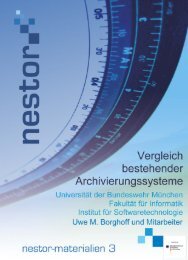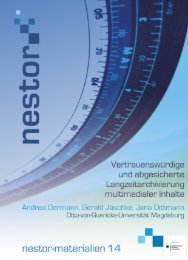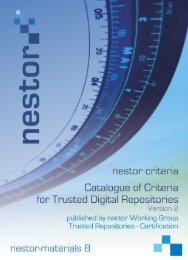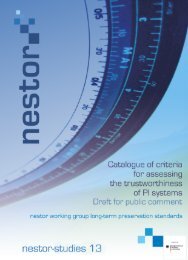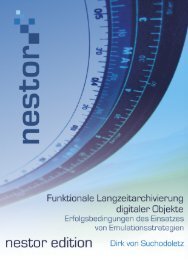Download (PDF, 9MB, Not barrier-free file.) - Nestor
Download (PDF, 9MB, Not barrier-free file.) - Nestor
Download (PDF, 9MB, Not barrier-free file.) - Nestor
- No tags were found...
You also want an ePaper? Increase the reach of your titles
YUMPU automatically turns print PDFs into web optimized ePapers that Google loves.
Thus it seems highly recommendable to leave the Access functional entity in theresponsibility of the repository entirely. We will see in the following, however, that thisdistribution of responsibilities also means that repository and preservation service providerhave to work out a detailed plan governing how communication between them takes place– that is, a set of well-defined rules has to be created which determine, for example, whichinformation packages are exchanged when and how. Among the issues that have to beaddressed according to Knight and Hedges are1. The method of enabling machine-to-machine transfer between two repositories;2. Maintaining consistent identifiers between the digital repositories;3. Maintaining authentic records between the digital repositories. (2007, 69)While the first and second issue can be solved by means of protocols (e.g. OAI-PMH),exchange formats and standards (e.g. UOF or ONIX 34 ), and persistent identifiers, the thirdissue in particular depends on more than merely “technical” considerations. Thus it needsto be agreed upon what happens if, for example, a digital object is migrated to anotherformat by the preservation service provider – if it is to be re-ingested into the repository, atwhich point and in which form will this be the case? How and to what extent will metadatabe updated and expanded as migrated objects are re-ingested into the repository? Howcan it be assured that the repository and/or repository users have the software needed todisplay the transformed digital objects at their disposal? 35Users accessing digital objects through a repository must be entirely certain that thedigital objects they receive are authentic copies of the original objects submitted to therepository – a requirement that any repository will have to meet, regardless of whether it isinvolved in long-term preservation efforts or not. Thus the repository, just like apreservation service provider, will therefore have the responsibility to protect the integrityand authenticity of the information packages on its servers. In consequence, a repositorycooperating with a preservation service provider needs to be able to make sure that onthe one hand the SIPs submitted to the long term archive for preservation contain digitalobjects that are uncorrupted; on the other hand the same needs to be guaranteed for theobjects and metadata contained in Dissemination Information Packages accessed by therepository users, as these will not be generated by the long term archive but from theinformation packages archived by the repository. As all of this makes very clear, even ifthe repositories considered here are not directly involved in taking concrete preservationaction, for example, by converting digital objects to a different format in response to thethreat of obsolescence, they nonetheless play an important part in curating these objectsover their lifecycle and hence form part of the preservation system and workflow (see theDCC Curation Lifecycle-model for a possible visualization of this lifecycle).34 See Steinke 2006 for information on the Universal Object Format (UOF) andhttp://www.editeur.org/8/ONIX/ for information on ONIX – 03.11.2009.35 On this issue, see, for example, chapter 9.2 of the nestor Handbuch (Neuroth et al. 2009).18



